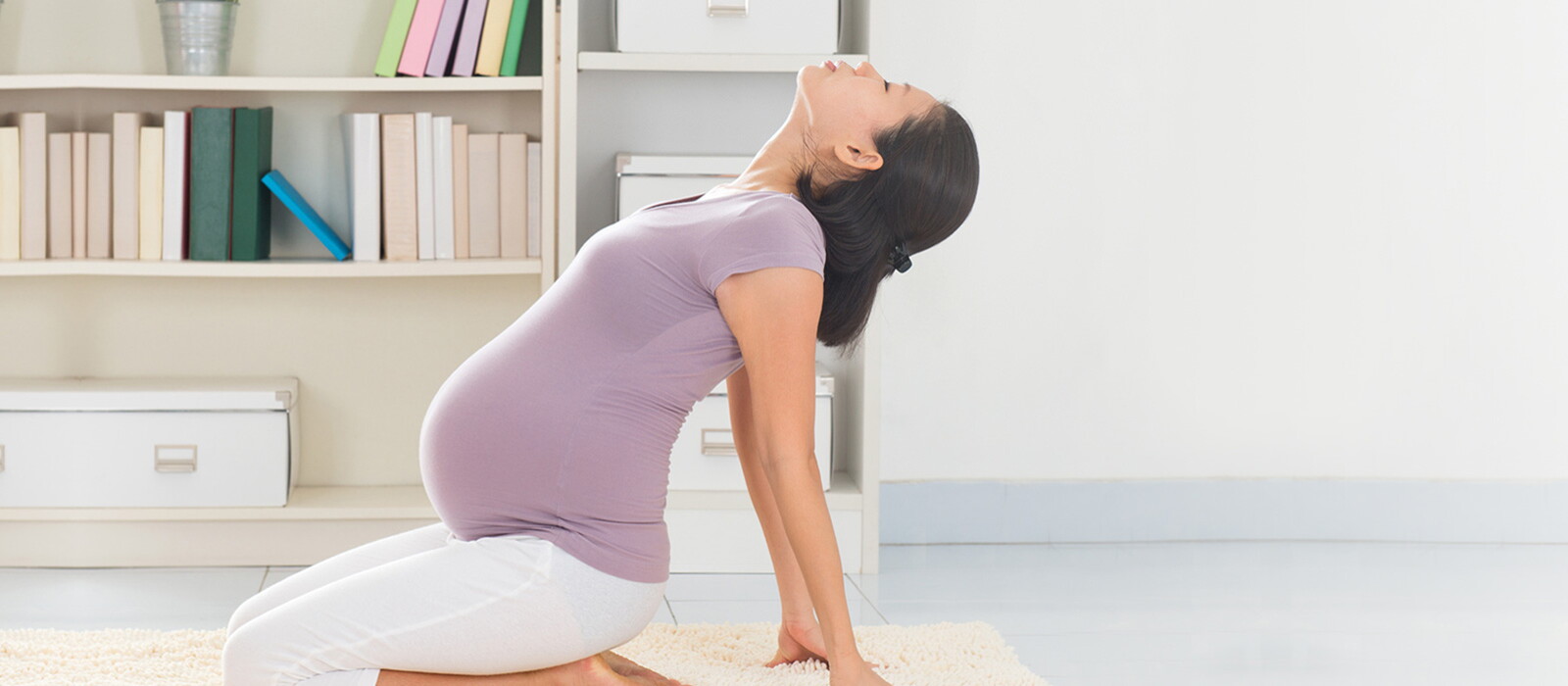Exercises like kegel exercise are healthy during pregnancy.
This article points out the importance of exercise before and during pregnancy, and provides tips on staying active. It also showcases exercises that would benefit pregnancy women.
Being pregnant will make great demands on your body, and exercise can help you meet those demands.
Some exercise is healthy for you during pregnancy as long as it is not excessive or strenuous. Women who exercise regularly during pregnancy gain less weight and body fat than women who are less active, but their weight gain stays within normal limits and their fetuses are as healthy as those of women who are inactive. Additionally, the labour and delivery of active women tend to present fewer difficulties.
If you are accustomed to sports, remember to stop when you get tired and don't allow yourself to overheat. If your pregnancy affects your sense of balance, walking may be preferable to more rigorous exercise. Your health care professional will advise you how much exercise you need and may also recommend special exercises to tone your muscles in preparation for childbirth.
Activity keeps you fit
Before you become pregnant, activity and exercise ensure that your body is fit enough to carry a healthy fetus to term. After you become pregnant, exercise builds muscles to protect your joints and spine. Being pregnant will make great demands on your body, and exercise can help you meet those demands.
If you have been exercising, you may want to continue in the same way you did before pregnancy. Or you may want to start a new form of exercise. In either case, always seek advice from your health care professional first. The important point is that the more active and fit you are, the less chance there is that you will be stiff and achy as your pregnancy continues.
Tips on staying active
No matter what exercise program you and your health care professional have decided on, there are a few basics you need to know about keeping fit. The following are a few exercise considerations:
- Never exercise to the point of fatigue or continue an exercise that causes you pain. You should be able to breathe easily while exercising; if you are out of breath, your fetus is too. Measure your heart rate (your health care professional will show you how) at the peak of your exercise. Your heart rate should not exceed 140 beats per minute.
- Even if you have never exercised, you can walk. If you are just starting to walk, go slowly and work up to 20 minutes a day. Don't worry about the speed at which you walk or the distance you cover—this isn't a race. In general, avoid competitive activity.
- Swimming is an excellent exercise that you can continue until term. Swim slowly and gently, and avoid cold water. You can also continue with bicycling and dancing during the first and second trimesters, but not acrobatics. Horseback riding and skiing are discouraged because of the risk of falling.
- There are special exercise classes for pregnant women in many community centers. Having a teacher to encourage and to correct your position may be helpful if you are new to exercise.
- Exercise should be regular and rhythmic. Try exercising to music.
- Even if you can't do your full exercise routine, do some exercise every day. Regular exercise is better for you than occasional exercise. Exercising with a partner may help you stick with it.
- Ask your health care professional about exercises you can do in a chair.
- Warm up first, whatever the exercise may be. Try 5 minutes of slow walking or stationary cycling with low resistance. Before you exercise, take a few deep breaths to get the blood flowing around your body and to send a good supply of oxygen to your muscles.
- When you stop exercising, cool down with gentle stationary stretches.
- Take a drink of water before and after you exercise, and, if necessary, stop your exercise for a drink.
- To avoid cramps, try not to point your toes for a long time.
- If you feel any unusual symptoms during or after exercise, stop the exercise and call your health care professional.
Basic exercise position
Lie on your back with your knees bent, your feet about shoulder-width apart and your soles flat on the floor. Support your head and shoulders with cushions and rest your arms flat at your sides. Only exercise in this position until the 4th month. Beyond this time, exercising on your back is not recommended because the growing uterus can put excessive weight on major blood vessels.
Kegel exercise
 Tense the muscles around your vagina and anus and hold them like this for as long as you can. Gradually increase the length of time you do this for until you can hold them for 10 seconds. After the 4th month, this exercise should be done in a standing or sitting position. Do at least 25 repetitions at various times during the day.
Tense the muscles around your vagina and anus and hold them like this for as long as you can. Gradually increase the length of time you do this for until you can hold them for 10 seconds. After the 4th month, this exercise should be done in a standing or sitting position. Do at least 25 repetitions at various times during the day.
Pelvic tilt
 Press the small of your back against the floor and exhale. Relax your spine as you inhale. Repeat this 3 or 4 times. The pelvic tilt can also be done standing up straight with your back against a wall (exhale while pressing the small of your back into the wall). The standing version is an excellent way to improve your posture and should be used after the 4th month.
Press the small of your back against the floor and exhale. Relax your spine as you inhale. Repeat this 3 or 4 times. The pelvic tilt can also be done standing up straight with your back against a wall (exhale while pressing the small of your back into the wall). The standing version is an excellent way to improve your posture and should be used after the 4th month.
Leg lifts
 Lie on one-side keeping your shoulders, hips and knees in a straight line. Support your head with the hand closest to the floor and put your other hand on the floor in front of you. Relax and inhale, then exhale while slowly raising the leg nearest the ceiling as high as you can, keeping your foot flexed (toes pointing toward your belly) and your inner ankle facing the floor. Repeat 10 times on each side. You can also do this exercise with the raised leg bent at the knee.
Lie on one-side keeping your shoulders, hips and knees in a straight line. Support your head with the hand closest to the floor and put your other hand on the floor in front of you. Relax and inhale, then exhale while slowly raising the leg nearest the ceiling as high as you can, keeping your foot flexed (toes pointing toward your belly) and your inner ankle facing the floor. Repeat 10 times on each side. You can also do this exercise with the raised leg bent at the knee.
Dromedary droop
 Crouch on your hands and knees with your back in a relaxed position without letting your spine sag. Keep your head straight and in line with your spine. Pushing the small of your back upwards, tighten your abdomen and buttocks and drop your head down. Gradually relax and return to the original position. Repeat 3 or 4 times. This exercise is helpful in relieving the pressure that the uterus places on your spine.
Crouch on your hands and knees with your back in a relaxed position without letting your spine sag. Keep your head straight and in line with your spine. Pushing the small of your back upwards, tighten your abdomen and buttocks and drop your head down. Gradually relax and return to the original position. Repeat 3 or 4 times. This exercise is helpful in relieving the pressure that the uterus places on your spine.
Tailor sit, tailor stretch
 Sit cross-legged and place your hands on your shoulders. Lift both arms above your head, stretching one arm higher than the other. Relax this arm and repeat with the other arm. Repeat 10 times on each side.
Sit cross-legged and place your hands on your shoulders. Lift both arms above your head, stretching one arm higher than the other. Relax this arm and repeat with the other arm. Repeat 10 times on each side.
Neck relaxer
 Sit cross-legged with your eyes closed. Inhaling slowly, gently drop your head to the side and roll it forward and around, make a half circle. Exhale and relax, letting your head drop forward. Repeat 4 or 5 times, alternating the direction of the roll. Do this exercise 3 or 4 times daily.
Sit cross-legged with your eyes closed. Inhaling slowly, gently drop your head to the side and roll it forward and around, make a half circle. Exhale and relax, letting your head drop forward. Repeat 4 or 5 times, alternating the direction of the roll. Do this exercise 3 or 4 times daily.
Disclaimer: This content is shared for informational purposes only and not intended to be a substitute for professional/medical advice, diagnosis, or treatment. We recommended that you always seek the advice of your healthcare professional for any questions you may have regarding a medical condition/specific situation.
References:





